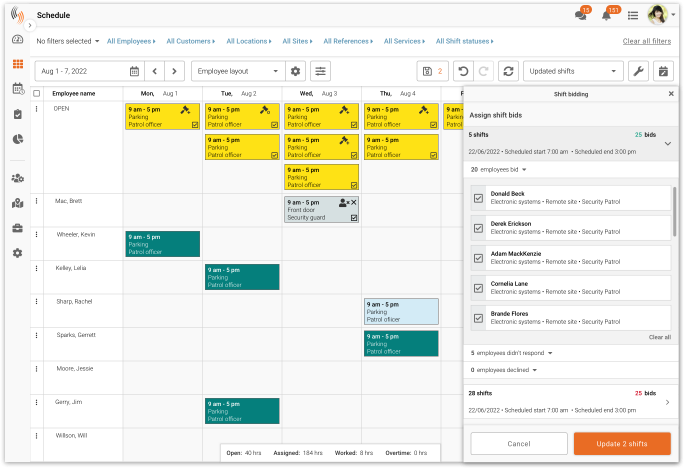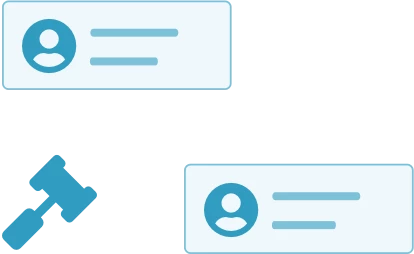What is Shift bidding?
Shift bidding is a process whereby one or more employees can express interest in working an open shift. It is an automated alternative method to scheduling that allows the scheduler to retain total control, while also giving employees say in their schedule preferences.
How Does Shift Bidding Work?

Shift bidding starts with your company’s schedulers. The schedulers can create the shifts that they would like employees to work. They can also set the qualifications for specific shifts if needed. A notification will then go out to all the employees, notifying them of the available shifts. Now, employees have a little bit of control over their work schedules.
Employees will only be able to see the shifts they qualify for. After receiving a notification, employees can select which shift they would like to work and submit their interest in the form of a “bid”. Shift bidding is similar to self-scheduling, however, we do not manage shift bidding on a first come-first served basis. Instead, schedulers can review the employees that have expressed interest, and make their own decisions from there.
With our rules-based scheduling, schedulers can access important information while scheduling after the bidding period. The information displayed includes which employees are qualified, and which employees are about to go into overtime. At this point, the scheduler can either manually enter each employee into a shift, or leave Celayix AI to autofill the schedule. Once the shifts are filled, the employees will receive a notification and will be able to view their schedule on their mobile.
Who can use Shift Bidding?
Shift bidding is most beneficial in any industry that works on variable or static schedules, such as manufacturing. Here are some examples of industries where we have seen shift bidding be successfully implemented;

- Security
- Manufacturing
- Home Health Care
- Long Term Care Facilities
- Call Centres
- Hospitality
- Cleaning Services
If your organization works on a schedule with multiple shifts per day and varying shift patterns, shift bidding is a great way to provide autonomy to employees while maintaining control over the schedule. But there are even more benefits to shift bidding.
Benefits of Shift Bidding
Giving employees more autonomy over their schedules can be daunting to employers. However, from experience, we’ve seen first-hand the benefits that come with it. Often, these benefits outweigh those of retaining complete schedule control. Take a look below to see why you should consider introducing shift bidding into your employee scheduling process.
IMPROVED EMPLOYEE ENGAGEMENT & RETENTION
With shift bidding, employees have the ability to choose what shifts they would like to work and when they would like to work. Your employees will feel empowered as they are actively involved in the schedule-making process. It creates the feeling of employee initiative and pro-activeness, which generally improves employee engagement. Shift bidding also increases the flexibility of employees’ shifts.
Flexibility in your employees’ lives can lead to a great amount of employee satisfaction and happiness. With a greater amount of employee happiness, employees are more likely to stay with your company. Research from the International Workplace Group found that 80% of workers would choose a job that offers flexible scheduling over those that don’t. This makes shift bidding a win-win for multiple aspects of the organization.
LESS TIME SPENT SCHEDULING
Saving time wherever you can is fantastic with everyone’s workday becoming busier and busier. With employees scheduling themselves, schedulers only have to create the layout of shifts they would like filled. The manager on-site can either manually choose who works each shift or use an automation feature such as Celayix AI to autofill every shift.
Celayix AI will optimize your schedule depending on a multitude of factors such as impending overtime pay or wage. Another benefit is that the schedulers do not have to collect all the employee’s preferences and availabilities.
Video: Shift Bidding and its Benefits Explained
With less time spent on scheduling, management resources can be focused elsewhere and used to improve other areas of the business. Celayix has helped companies reduce their scheduling time by 2 weeks. Not only that, but our shift scheduling software can reduce scheduling errors such as double-booking or over/understaffing.
These schedule improvements save you money and improve your bottom line. If you’d like to see how much money you could save with Celayix, visit our Cost-Benefit Analyzer here!
REDUCED ABSENTEEISM
Absenteeism is a huge issue for organizations today. Typically, factors such as family reasons, depression, stress/burnout, and poor punctuality contribute to the problem of absenteeism. Offering flexible options such as shift bidding decreases the likelihood of employees missing shifts, or even arriving late.
When they select their own shifts, they’ve likely accounted for any reasons that would prevent them from turning up on time, or at all. Absenteeism impacts both productivity & profitability, so any steps that you can take to avoid or reduce it should be a high priority.
ELIMINATE UNNECESSARY OVERTIME

As mentioned above, schedulers can view each employee that has submitted a bid for the open shifts. While doing so, they can filter the employees to ensure that no employees will be assigned to a shift that would send them into overtime. Celayix has saved companies over $100,000 in overtime, and can certainly help you to eliminate any unnecessary overtime from your schedule. As you can see, shift bidding has multiple benefits for you, your organization, and your employees.
The easiest way to implement shift bidding into your scheduling process is to use shift scheduling software like Celayix. Our shift bidding systems are accompanied by other flexible scheduling options and other tools to make scheduling as easy as possible for you.
If you’d like to find out more about when you should use shift bidding vs. self-scheduling, you can read more here. Employers are forced to step up and make changes with employees continually searching for a better work-life balance. Let us do all of the heavy lifting for you! Get in touch with a Solution Advisor and see how Celayix can help your organization.





